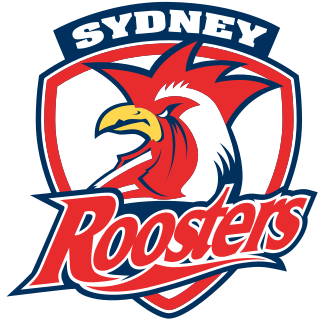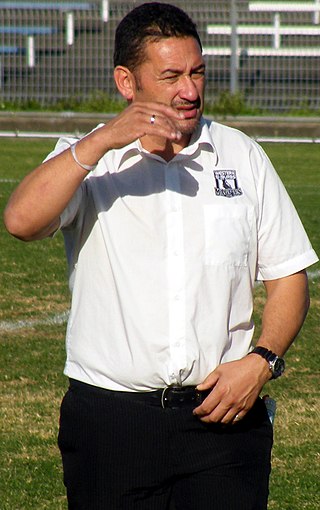
The Sydney Roosters are an Australian professional rugby league football club based in the Eastern Suburbs and parts of inner Sydney including the CBD. The club competes in the National Rugby League (NRL) competition. The Roosters have won fifteen New South Wales Rugby League (NSWRL) and National Rugby League titles, and several other competitions. First founded as the Eastern Suburbs District Rugby League Football Club (ESDRLFC), it is the only club to have played in every season at the elite level, and since the 1970s has often been dubbed the glamour club of the league. The Sydney Roosters have won 15 premierships, equal to the record of the St George Dragons. Only the South Sydney Rabbitohs have won more premierships. The club holds the record for having won more matches than any other in the league, the most minor premierships and the most World Club Challenge trophies. The Sydney Roosters are one of only two clubs to finish runners-up in their inaugural season. Currently coached by Trent Robinson and captained by James Tedesco, the Roosters play home games at the Sydney Football Stadium.
John Edward Thornett, MBE was an Australian rugby union player, who played 37 Tests for Australia between 1955 and 1967 and made an additional 77 representative match appearances. He captained Australia in 16 Test matches and on an additional 47 tour matches on the eight international rugby tours he made with Wallaby squads.
Kenneth William Catchpole was an Australian rugby union footballer. A state and national representative half-back, he played twenty-seven matches for Australia, thirteen as captain. Catchpole rose through the ranks at the Randwick club as a young man, before making his debut for New South Wales at only 19 years of age, then captaining Australia at age 21. He is considered one of Australia's greatest rugby scrumhalves.
Brett Papworth played first grade rugby league for the Eastern Suburbs Roosters in the New South Wales Rugby League competition. He had formerly been an Australian rugby union international. His position of choice was usually at centre.

Arthur 'Pony' Halloway (1885–1961), was a pioneering Australian rugby league footballer and coach. Born in Sydney, New South Wales he played for the Glebe Dirty Reds (1908), Balmain Tigers and Eastern Suburbs (1912–1914), in the New South Wales Rugby Football League premiership. He played for New South Wales in the first rugby match run by the newly created 'New South Wales Rugby Football League' which had just split away from the established New South Wales Rugby Football Union.
John Brass is an Australian former rugby union and rugby league footballer – a dual-code international. He made twelve international representative rugby union appearances with the Wallabies from 1966 to 1968 and six representative rugby league appearances for the Kangaroos in 1970 and 1975, as national captain on one occasion.
Phillip Francis Hawthorne was an Australian rugby league and rugby union footballer – a dual-code international. He represented the Wallabies in twenty-one Tests and the Kangaroos in three Tests. He captained Australia in rugby league the 3rd Test of the 1970 Ashes series. His mother was killed in a car accident in Newcastle when he was 14.

Arthur James Summons was an Australian representative rugby union and rugby league player, a dual-code rugby international fly-half or five-eighth. He captained the Australian national rugby league team in five undefeated test matches from 1962 until 1964 and later also coached the side.

Christopher Hobart McKivat was an Australian rugby union and rugby league player – a dual-code rugby international. He represented the Wallabies in over 20 Tests and tour matches from 1907 to 1909 and the Kangaroos in 5 Tests from 1910 to 1912. He is unique in Australian rugby history as the only man to captain both the national rugby union and rugby league teams. Following his playing career he became the most successful coach of North Sydney in the club's history.
Ronald James Lisle was an Australian rugby union and rugby league player and a dual code rugby international. He represented the Wallabies in 4 tests in 1961 and the Australia national rugby league team in 13 matches on the 1963 Kangaroo tour.

Herbert R. Gilbert was an Australian rugby league and rugby union player – a dual-code international. He represented the Wallabies in three Tests in 1910 and the Kangaroos in seven Tests from 1911 to 1920, his last two as captain. The captain-coach of the St. George Dragons club in Sydney in their inaugural season, he is considered one of Australia's finest footballers of the 20th century. His sons, Herb Gilbert, Jr and Jack Gilbert were also notable rugby league footballers.
Clarence Warwick Prentice was an Australian rugby union and rugby league footballer who represented his country at both sports - a dual-code rugby international. He is the younger brother of fellow Wests player Ward Prentice.
Geoffrey Colin Richardson is an Australian former national representative rugby league and rugby union player – a dual-code international. He played union at fly-half and league at five-eighth.
Robert Henderson Graves was a pioneer Australian rugby league and rugby union player and one of his country's first dual-code internationals. He was a versatile forward for the Australia national team. He played in 6 Tests between 1908 and 1909, as captain on 1 occasion. In 1907 he played for New South Wales in the first rugby match run by the newly created 'New South Wales Rugby Football League' which had just split away from the established New South Wales Rugby Football Union.

Jason Paul Williams is a New Zealand former professional rugby league footballer who played in the 1980s and 1990s. A New Zealand international representative winger, he played his club football in Australia for Sydney's Western Suburbs Magpies, Eastern Suburbs Roosters, South Sydney Rabbitohs, Canterbury-Bankstown Bulldogs and the Penrith Panthers as well as in England for Salford. Williams played 145 games in the Australian competition from 1987–88 and 1991–98, scoring a total of 63 tries and winning the 1995 ARL Premiership with the Canterbury club. Williams played in 12 test matches for New Zealand between 1991 and 1995, scoring one try. He played in one non-test international on the 1993 Kiwis tour against Wales and two World Cup matches.
Albert Bentley "Son" Burge was an Australian rugby union lock who played with the Souths rugby union club in Sydney and at the age of nineteen was selected for the Australian national team in two Tests against New Zealand in 1907.

Peter Harold Boyne Burge was an Australian rugby footballer and coach. He represented his country in both rugby league and rugby union. The eldest of the four Burge brothers, Peter was one of the first Australian dual-code rugby internationals.
Darren Kevin Junee is an Australian former rugby union and rugby league footballer. He was an Australian rugby union representative and had a first grade rugby league career with the Sydney Roosters in the NSWRFL competition.
Between October 1966 and March 1967 the Australia national rugby union team – the Wallabies – conducted a world tour on which they played five Tests and thirty-one minor tour matches. Under the captaincy of John Thornett they toured UK, Ireland, France and Canada winning nineteen matches, losing fourteen and drawing three. At one stage they failed to win in four successive matches although in the Test match against England they gave the home side its heaviest defeat in 16 years. The tour marked the climax of the successful "Thornett Era" of Australian Rugby, buoyed by the leadership skills of skipper John Thornett and the outstanding abilities of greats of the game like Ken Catchpole, Peter Johnson and Rob Heming. Dick Marks and Peter Crittle also toured and would later become among the most influential administrators of Australian rugby.
Peter David Sullivan is an Australian former national representative rugby union player. He represented for New South Wales and Australia, captaining the national side on eleven occasions from 1972 to 1973.